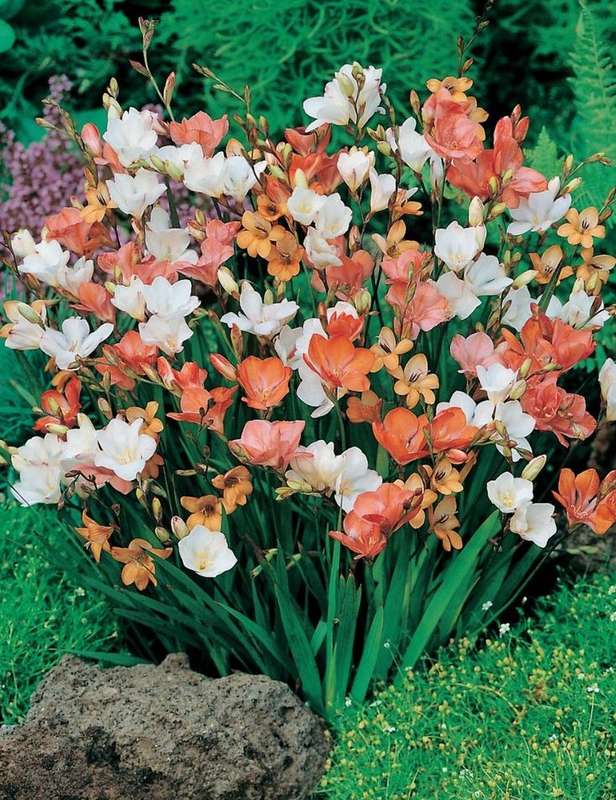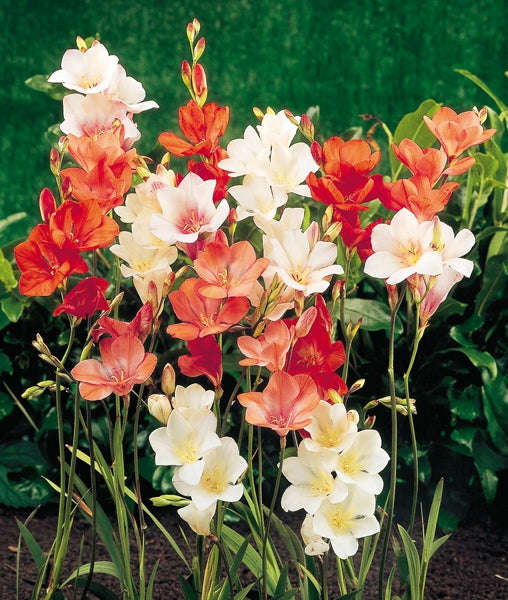



Tritonias - Mixed - 25 bulbs p-pack
Check my rate
| Main centres: | 1-3 business days |
| Regional areas: | 3-4 business days |
| Remote areas: | 3-5 business days |




| Main centres: | 1-3 business days |
| Regional areas: | 3-4 business days |
| Remote areas: | 3-5 business days |
Tritonia, commonly known as "Flame Freesia", is a vibrant and hardy bulbous plant that thrives in the mild winters and spring seasons of South Africa. The Tritonia Mix offers a beautiful range of colors, including shades of red, orange, yellow, and pink, adding a burst of color to gardens, flower beds, and containers. This flowering plant is well-suited to South African conditions and is relatively easy to grow with minimal care.
Climate:
Tritonias are best suited to mild winter and cool spring temperatures (around 15—20°C).
Ideal for planting in autumn (March—May) for spring flowering (August—October).
Best suited for regions with cool winters like the Western Cape and Highveld areas.
Hot summers can be challenging, so it's important to plant in well-drained soil and avoid excessive heat exposure.
Soil Requirements:
Prefers well-draining, sandy-loam or loamy soil to avoid waterlogging, which can lead to bulb rot.
pH level: 6.0—7.0 (slightly acidic to neutral).
Amend heavy clay soils by mixing in organic matter or sand to improve drainage.
Best Planting Time:
Autumn (March—May) for spring blooms (August—October).
Plant when the soil temperature is below 20°C, which is typical for autumn planting.
Preparing the Bulbs:
Soak the bulbs in lukewarm water for about 2—4 hours before planting to promote sprouting.
Let the bulbs dry slightly after soaking to prevent fungal growth.
Planting Depth & Spacing:
Depth: Plant bulbs 5—7 cm deep with the pointed end facing up.
Spacing: Space bulbs 10—15 cm apart to allow for optimal growth and airflow.
Row spacing: Leave 20—30 cm between rows for proper circulation and to reduce the risk of fungal infections.
Watering:
Keep the soil moist but not waterlogged during the growing season.
Water deeply once or twice a week depending on the weather, ensuring the soil is not left soggy.
Reduce watering when the foliage starts to die back, indicating the plant has gone into dormancy (around late spring).
Fertilizing:
Before planting, mix organic compost or well-rotted manure into the soil.
Apply a balanced fertilizer (NPK 10-10-10) or one that is higher in phosphorus to promote flowering.
Fertilize every 4—6 weeks during the growing season for a stronger flower display.
Mulching:
Apply a thin layer of mulch around the bulbs to help conserve moisture and suppress weeds, but avoid heavy mulching that could suffocate the bulbs.
Common Pests:
Aphids, thrips, and spider mites — Use neem oil or insecticidal soap to control pests.
Slugs and snails — Protect bulbs with organic slug pellets or copper tape to prevent damage.
Common Diseases:
Botrytis (gray mold) — Improve air circulation by spacing plants appropriately and avoid watering over the foliage.
Root rot — Ensure the soil is well-drained and avoid overwatering, especially in winter months.
Blooming Time:
Tritonia Mix blooms in early spring, usually 8—12 weeks after planting (from August to October).
The flowers will last for several weeks, adding a stunning splash of color to your garden.
Cutting for Bouquets:
Cut flowers when they are just beginning to open to maximize their vase life.
Use sharp scissors or pruning shears to avoid damaging the plant.
Place cut flowers in cool water immediately to extend their freshness.
Tritonias make excellent cut flowers, and their blooms last 7—10 days in a vase.
After flowering, allow the foliage to die back naturally to ensure the bulbs store energy for next season.
Dig up the bulbs once the foliage has yellowed and dried, and allow them to dry completely in a cool, dry location.
Store the bulbs in a paper bag or cardboard box in a cool, dark, and dry place until autumn.
Replant in autumn for the next season's flowers.
Good Companion Plants:
Tulips, daffodils, and freesias complement Tritonias in spring displays.
Low-growing...